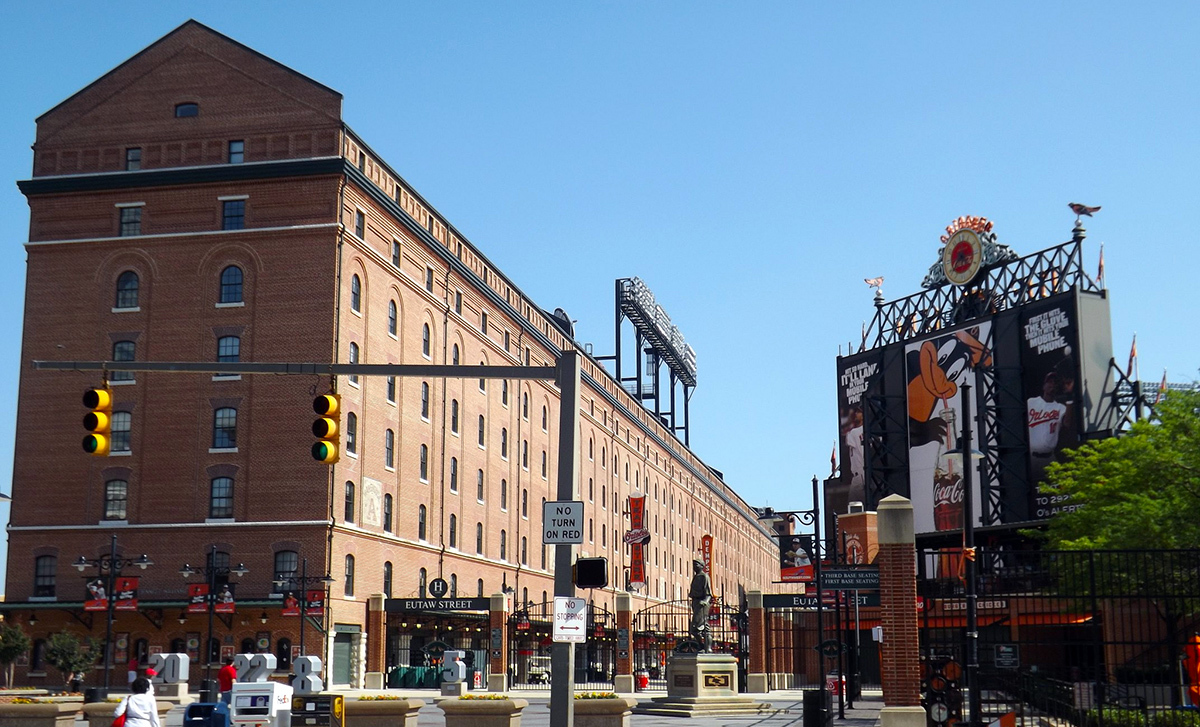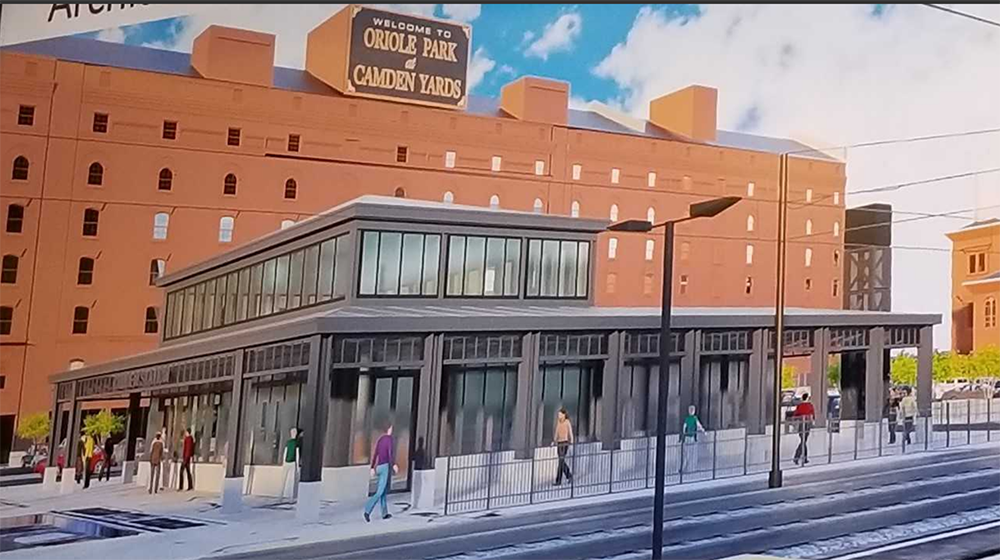
Baltimore will soon get a new train station that will serve as a southern gateway to the city, replacing a “temporary” facility that’s been in operation for more than 25 years.
Construction is scheduled to begin this fall on a $7.2 million terminal next to Oriole Park at Camden Yards, with completion expected by mid-2019. The station will replace a low-budget structure that was built quickly to serve rail passengers in time for the 1992 opening of Oriole Park—two prefab trailers covered by a space frame roof.
Designers offered a first look at their “preliminary concept” for the replacement station during a recent meeting of the Maryland Stadium Authority board of directors. Their renderings indicate that the building will not be a retro version of an old-fashioned depot, but it won’t look futuristic either.
Predominant materials will be brick and steel, as they are at Oriole Park. But painted surfaces likely will be gray, rather than the Camden green used on the ballpark. A 35-foot-tall pylon will help make it visible from blocks away.
“Contextual” is the best way to describe the design approach, said architect Paul Diez, of AECOM Technical Services, the firm working on the project. “One of the things we were told is that [the clients] want it to look like it’s been there. Not a ‘look at me’ building, a contextual building.”
In terms of the architecture, “our goal was to take some of the elements of the stadium complex” and use them to set the tone for the train station, Diez told the stadium authority board. Common elements include brick walls, steel supports, a standing seam metal roof, and a stone base. “That became our vocabulary,” he said.
The station will be constructed just east of the B&O Warehouse, on the same site as the current facility. It’s expected to provide a new entrance to downtown for rail passengers who take the Camden Line of the Maryland Area Rail Commuter (MARC) service, which connects Baltimore and Washington, D.C.

The station is a joint project of the Maryland Department of Transportation’s Mass Transit Administration, which operates the MARC line, and the stadium authority, which is serving as the project manager. It’s fully funded, with $6 million coming from the Federal Highway Administration and the rest coming from the State of Maryland.
“The MARC Camden Station serves as the entry point for commuters as well as visitors to Baltimore,” said Kevin Quinn, MTA administrator, in a statement. “We are thrilled that a new cutting-edge facility will soon be serving our customers at Camden Yards.”
The stadium authority looks forward to a “new station that complements the historic and iconic Camden Yards sports complex” said chairman Tom Kelso.
Philip Hutson, the stadium authority’s associate vice president for capital projects and planning and project director for the station, told board members that construction is scheduled to begin shortly after the 2018 baseball season ends, and be complete by May or June of 2019, shortly after the 2019 baseball season starts.
Hutson said rail service will continue at Camden Yards while construction is underway and pedestrian access will be provided to the trains just outside the fenced off construction site.
Diez said the station will be a one-structure, with clerestory windows to let in natural light. The roof will be standing seam metal, most likely with a zinc coating that will turn gray as it weathers, he said. The station will be able to accommodate about 90 passengers at one time, with seating for about 30, and it’s being designed to include a ticket purchase area with live agents, not just machines. The station will also have room for a police substation and vending machines for food.
Oriole Park gained attention as a new-fangled, old-fashioned urban ballpark that combined traits found in historic venues with amenities that fans have come to expect from contemporary stadiums.
Some early studies for a permanent MARC station, developed in the 1990s by HOK Sport and others, suggested that the state build an old-fashioned train depot as well. To have a station in place in time to meet the 1992 opening deadline for Oriole Park, the state ended up building a utilitarian structure that didn’t harken back to the past.
In AECOM’s presentation, one rendering depicted the replacement station as having bricks that were darker and grayer than the red-orange bricks on the B&O Warehouse, almost like the ironspot bricks on the Joseph Meyerhoff Symphony Hall. Diez said the actual color has not been chosen, but the goal is to come close to the color of the bricks on the warehouse and other Camden Yards buildings.
A 35-foot-tall pylon has been designed to rise beside the main building, serving as signage and a wayfinding device that can be illuminated after dark. “This becomes a beacon, a lantern at night,“ Diez said.
Hutson said the Baltimore Orioles have been advised about the plans and provided some feedback. He indicated they would like to see some refinement of the north façade, which presents a largely blank wall to the historic Camden Station a block away.
Funding for the new station includes $6 million from the Federal Highway Administration and $1.2 million from the state. The Maryland Transit Administration is taking the lead on planning and design, and the stadium authority is providing project management. Barton Malow is providing pre-construction management services.
While the footprint of the replacement station will be the same as the current building, at least one trait will be very different. The current station was always meant to be replaced eventually, but the designers of the replacement station are working to make sure it lasts for generations, Diez said. “It’s designed to have a 100-year life.”
